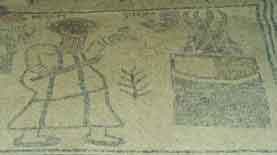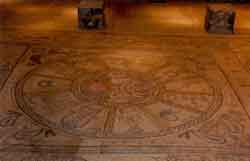Beit Alpha
The ancient synagogue of Beit Alpha is located in the Beit She'an
Valley, in the north-east of the country.
The nearby ruins of Khirbet Beit Ilfa preserve
the ancient name.
The mosaic floor of the synagogue
was discovered in 1929, when members of Kibbutz
Beit Alpha dug irrigation channels for their
fields. Excavations were carried out the same
year, exposing mosaics preserved intact for
almost 1,500 years. Later excavations, in
the early 1960s, exposed remains of some houses,
indicating that the synagogue had stood in
a Jewish village of the Byzantine period (5th-6th centuries).
The synagogue is oriented southwards, toward Jerusalem.
It measures 20 x 14 m. and consists of a courtyard
(atrium), a vestibule (narthex) and a prayer
hall. The walls are of undressed stone, with
plastered inner and outer faces.
The courtyard is reached from the street,
via an opening in its western wall. It measures
10 x 7 m. and is paved with mosaics in geometric
designs.
The 2.5 m.-wide vestibule has two doors in
its northern wall facing the courtyard and
three doorways in its southern wall providing
access to the prayer hall. Its mosaic floor
is also in geometric patterns.
The prayer hall measures 10 x 8 m. and is
divided by two rows of stone-built pillars
into a central nave and two side aisles. The
pillars probably supported the arches and
the gabled roof of the synagogue. Scholars
assume that there was a second storey above
the two aisles and the vestibule, serving
as a women's gallery. Benches were built along
the long walls and along the southern wall
of the prayer hall. A door in the western
wall led into a side room.
An apse, a rounded raised recess 2.4 m. deep,
was built into the southern wall of the synagogue
and served as a bema on which the Torah Ark stood, with three steps leading up to it.
At a later time, another bema in the shape
of a bench was added between the two southern
pillars on the eastern side of the prayer
hall. A one meter-deep depression lined with
stones below the floor of the bema probably
served as the synagogue's treasury. When opened
during the excavations it contained thirty-six
Byzantine bronze coins.
The mosaic floor of the prayer hall
The entire prayer hall is paved in mosaic.
The floor of the western aisle is decorated
with squares in geometric patterns; the eastern
aisle is entirely paved in undecorated white
mosaic.
Two dedicatory inscriptions, one in Aramaic
and one in Greek, are situated just inside
the main entrance to the prayer hall, flanked
by a lion and a bull facing each other. The
Aramaic inscription states that the mosaic
floor was laid during the reign of Emperor
Justin (probably Justin I, beginning of the
6th century) and that the cost was covered
by donations from members of the community.
The Greek inscription reads: May the craftsmen
who carried out this work, Marianos and his
son Hanina, be held in remembrance.
The colorful mosaic floor of the nave is
divided into three distinct panels, all enclosed
by a decorated band with a variety of motifs:
geometric patterns, fruit, birds and animals.
The panels depict, from north to south:
The binding of Isaac
As described in Genesis
22:1-19. On the right is an altar with
flames rising from it. Abraham stands next to it, one hand holding his son Isaac and the other a long knife. The names of Abraham
and Isaac are inscribed above the figures.
A hand emerges from a cloud above Abraham
and Isaac, symbolizing the angel of God. Nearby
are the Hebrew words meaning "lay not
your hand [upon the lad]". The ram and
the two servants with the donkey are depicted
behind Abraham.
The Zodiac
Appears in the central
panel. These astrological signs, though condemned
by the prophets, were widely used as decorative
elements in both churches and synagogues of
the Byzantine period. The twelve signs are
arranged in a circle and accompanied by their
Hebrew names. In the center of the zodiac,
the sun god Helios is represented seated in
a chariot drawn by four horses. The four seasons
appear in the corners of the panel in the
form of busts of winged women wearing jewels;
they are inscribed with the Hebrew months
initiating each season: Nisan (spring), Tamuz
(summer), Tishri (autumn) and Tevet (winter).
The Torah Ark
Is depicted in the rear
panel in front of the apse, with a gabled
roof and behind a curtain. On either side
of the ark is a lit menorah (candelabrum), and traditional Jewish ritual
objects: shofar (ram's horn), lulav (palm branch), ethrog
(citron) and incense shovel. The ark is protected
on both sides by heraldic lions.
The splendid mosaic floor of the ancient
synagogue of Beit Alpha is one of the finest
uncovered in Israel.
It is unique in both motifs and workmanship.
The synagogue itself was small and simply
built, but its mosaics represent a folk art
that is striking, very colorful and rich in
motifs. The synagogue was in use during the Byzantine and the Early Islamic periods (7th-8th centuries).
The remains of the synagogue and its mosaic
floors have been preserved in a new, covered
structure which is open to visitors.
Sources: Israeli
Foreign Ministry. Photos courtesy of Jack
Hazut |

